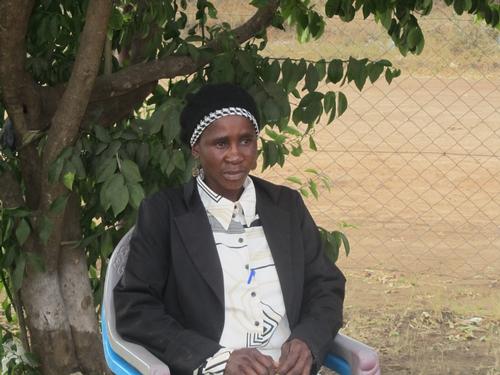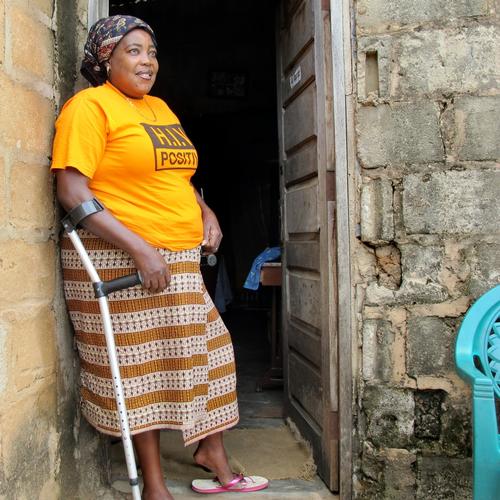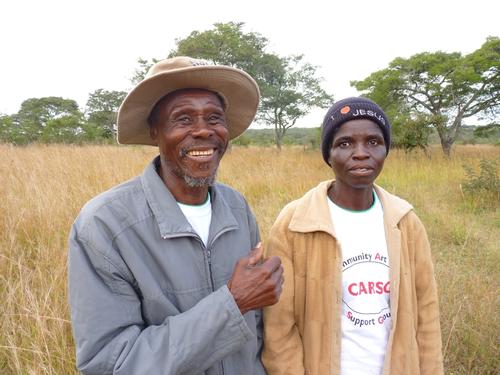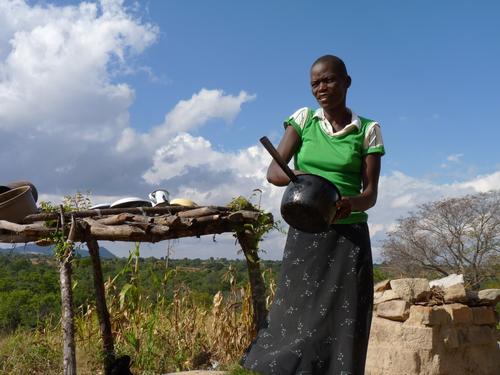Six neighbours from the same village, all of them HIV-positive and stable patients on antiretroviral therapy (ART) – the treatment that manages to keep the virus in check – take turns to go and pick up their medicines: every month, one of them goes to the hospital in everyone’s name. This is the essence of the so-called Community ART Groups (CAG), a simple, inexpensive initiative benefiting both members of the group and health facilities, started by Médecins Sans Frontières (MSF) in 2013 in Tsholotsho district.
Sehlelo Ndlovu, 41, is a member of the Lindani CAG. She started taking antiretrovirals (ARV) in 2009 after her husband died. “I think that my health worsened due to the stress caused by his loss as he was the family’s breadwinner.” Thanks to the CAG, she has managed to cope better with the disease. “Each one of us in the group plays a role, we monitor how to take the medicines, we count the pills of each member every month and note down what we discuss in the group. What I always thought was very difficult has now become easy in the group,” she says.
CAGs improve retention
The aim of the CAGs is to improve the retention of patients on ARV, reducing the number of visits to the health centre or hospital to collect their medicines. Avoiding treatment interruptions or discontinuations is one of the main challenges in the countries most affected by the pandemic. A recent study of the programmes in Sub-Saharan Africa concludes that, on average, nearly a third of the patients had been lost during follow-up within the first two years on antiretroviral therapy.
There may be many reasons behind the interruption or discontinuation of antiretroviral treatment. According to the MSF team in Tsholotsho, a lack of means to travel from the community to the health centres and the incompatibility of travelling due to work or family commitments are among the most common reasons. Once at the health centre, patients have to face long waiting times and, sometimes, a lack of support or discrimination.
“This initiative was designed jointly with the patients and as a response to the barriers to treatment adherence that they themselves were reporting. This is why it is a good alternative model for giving ARV to stable patients,” explains Susana Villén, MSF medical coordinator in Zimbabwe. Pregnant women, children and patients with TB or other opportunistic diseases cannot be part of the CAGs, because they need a more exhaustive medical follow-up.
How do the CAGs work?
Every month, before the visit to the clinic the group meets in the community. The group representative chairs the meeting and counts the medicines of each member (adherence review). Any new symptom, adherence problem or intended interruption is discussed and documented.
The representative changes each month and their appointment follows several criteria: if someone is not feeling well or needs to do a CD4 count test or to be weighed. If no one meets these requirements, s/he is chosen according to a pre-established calendar. All of the members of the group hand their “patient book” to the representative.
In the clinic, the representative first undergoes a consultation in his/her own name. Then s/he meets the health staff that prescribes the ARV and prophylactic medicines needed by the whole group. The patient books are updated and the medicines are packed under each patient’s name to prevent delivery mistakes. The representative returns to the community and hands out the medicines to each member, returns the patient book and, if necessary, tells them to go to the health centre for follow-up.
Decongesting health centres
In 2013, the CAGs started in three health centres in Tsholotsho: Nkunzi, Sipepa and Pumula. These locations were chosen because there were many people on ARV treatment who lived far away and had to travel there to collect their medicines and because public transport was lacking. 720 people formed 121 groups. MSF was responsible for training the CAG members and liaising with the health centres.
“For the CAGs to work, the participation of the health centre staff is essential,” says Villén. “It is important to explain very well how these groups work. For the health centre, it is also an advantage. Rather than attending six people, they only see one. What we are trying to do is get the person in charge of dispensing the medication to have it ready beforehand. Thus, the consultation is shorter and we decongest the already very over-congested health centres.”
Despite major progress in the past few years, Zimbabwe is still one of the countries most affected by HIV/AIDS in the world, with nearly 15% of the adult population infected by the virus (1.3 million people). According to the Ministry of Health and Child Welfare, about 72% of adults and 43% of children in need of ART, were in treatment in 2012.
“For the health system to be sustainable and successful in the long term in countries such as Zimbabwe, we need healthcare models that separate clinical patient management, which require trained health professionals, and the dispensing of medicines that non-medical people can do,” explains Luis Encinas, MSF operations manager responsible for the Zimbabwe projects. “In the second case, patients play a much more active and informed role in the physical, social and psychosocial aspects of their health.”
More time for work and family
Clorence Masango, 48, is married and has seven children, all of them HIV-negative. “I live 18 kilometres from Pumula, but the distance shortened when I joined the Damulocingo CAG,” he explains. “The group has helped us a lot. We no longer waste the whole day in hospital. The CAG members are easily identified and seen in less than two hours. It’s a big improvement; we used to spend more than six hours at the hospital. Thanks to the CAGs, we have more time to work for our families. Now I am more relaxed and live positively. I think that this is the happiness I need to go on. I learned a new purpose in life…helping others is good.”
Since late last year, MSF has been gradually handing over its activities in Tsholotsho to the Ministry of Health in Zimbabwe. Within this process, the CAGs started to work without the organisation’s support from early this year. “This is a very sustainable initiative. We know that many people have created new CAGs, because they see their advantages very quickly,” explains Susana.
* Beating the virus is a series of stories aiming to explain how HIV programmes have changed the daily life for thousands of HIV-positive people in Zimbabwe. MSF has been working for years on HIV and TB comprehensive programmes, adopting a community approach. The work is based on pillars such as: treatment simplification, task shifting to redistribute HIV attention among medical and not medical staff, the integration of HIV healthcare in routine health services and decentralisation to the rural area.
In Tsholotsho, MSF has been working for more than nine years on comprehensive HIV and TB care. Given the good results, the organisation will stop working in the district in the coming months, but will continue to treat HIV and TB patients in other parts of the country.






